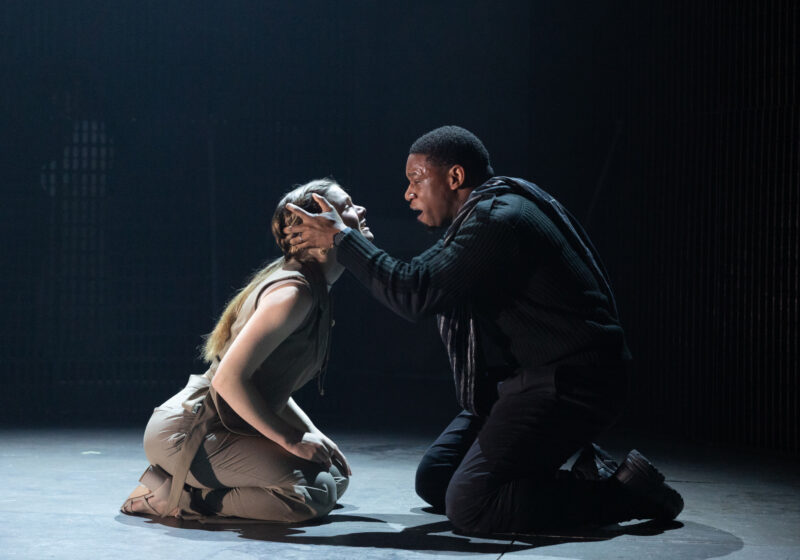The Rochester Contemporary Art Center (RoCo) occupies a very small, unassuming space on East Avenue in downtown Rochester. For its entirely glass front and simplistic signage, one could almost walk right past it — my friends and I actually did, twice. Upon walking in to see their current exhibit, “’Scapes,” the theme of minimalism continues in the form of the number of pieces and how they are displayed. Yet, “’Scapes” has anything but a minimalist message or effect on its viewers.
A relationship between human bodies and their surrounding landscapes is the connecting theme for all seven works of art displayed. Rochester artists Sterz, Jason and Debora Bernagozzi, Christina Laurel and Spokane, Wash. artist Jamie Hahn each take a very personal interpretation of this theme, but almost all of the artists employ unconventional uses for electronic media as their means for representation.
Mr. Bernagozzi has two installations featured, one of which is called “Dataspeak,” and it sits boldly in the middle of the RoCo’s floor. “Dataspeak” positions four 13-inch TV monitors facing each other from their own boxy, white pedestals. In order to see this installation, visitors have to unnervingly stand in the center of the screens.
Each screen portrays a different person, whose face, upon beginning to speak, breaks up into pixelated fragments — similar to how a video can become disjointed during a Skype videochat. As soon as the individual is done speaking, however, their picture returns to normal.
The message here is more of a question, which asks about the intricacies of conversation. In order to look at one screen, the viewer’s back is to the other three, one of which begins to break down. Just as the viewer turns his or her attention to that screen, though, a person on another monitor begins to break down. Thus, having the viewer stand in the middle of these screens causes him or her to have to “negotiate the alienating experience of the installation environment” with the etiquette of conversation, according to Mr. Bernagozzi.
One of Ms. Bernagozzi’s pieces — called “Stream” — is huddled in a secluded corner of the room behind a curved wall so that in order to see the piece, one has to completely isolate him or herself from everything else. Immediately upon entering this partial room, you are struck by a row of television screens of different sizes that are showing abstract images of tree trunks floating in a stream at different speeds and with different amounts of static noise in the background.
The effect is extensively creepy and reminiscent of “The Ring,” despite the fact that Ms. Bernagozzi said, “some [screens] contain sensuously flowing images suggestive of human forms.” Perhaps this meant to describe the screens with images that were moving more slowly and with less static, but I found that no single screen stood out enough to evoke individual feelings, such as sensuality. Instead the overall representation creates an extremely hostile environment.
Her other artwork hangs at the front of the gallery and is the first piece from the exhibit that you see when you walk in. “Electronic Landscape” was made by manipulating electronic signals to look like black and grey ink prints of landscape imagery, which hung in four individual frames on the wall. In a way, for all of its docility, “Electronic Landscape” made “Streams” stand out more than it would have on its own, despite that her two artworks were not exclusively tied to one another.
My personal favorite installation was the only non-electronic piece, Laurel’s “Ethereality” — the antithesis to “Stream” in every way. This installation is, like “Stream,” cordoned off from the main room so that when you enter, the only thing you experience is the effect of the piece and nothing else. Unlike “Stream,” though, Laurel’s work evokes the most intense calmness.
Laurel was inspired by “Edo” — or “floating world” — period of Japanese art in creating partially transparent columns made from paper “fabric” shades and suspended from the ceiling. Inside them are opaque cut outs of butterflies, gingko leaves and other natural things that are noticeable to varying degrees depending on how the columns are blowing around in the air. “While viewers circle each cocoon, their movements subtly influence the rotations within and without,” Laurel said of her work.
Finally, there are Sterz’ two projection installations. Both were meant to imitate the effect of light on water as seen by the eye, but to me they looked more like representations of red and white blood cells. Nonetheless, the idea of projecting moving images on canvas, which usually contain still, painted images, was an interesting mixed media technique.
“’Scapes” will be at the RoCo until Nov. 13, and is definitely worth checking out, as it poses some thought-provoking questions in a unique presentation. While it is a much smaller scale exhibit than one usually expects to find, it fits the stature of the museum itself perfectly, and, at only $1 for admission, this definitely makes for an outing that’s kind on a college student’s wallet.
Sklar is a member of the class of 2014.




